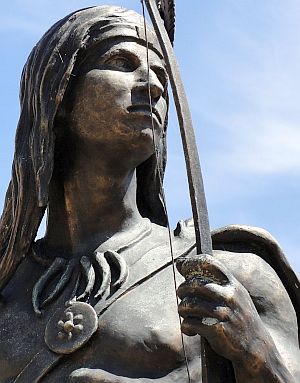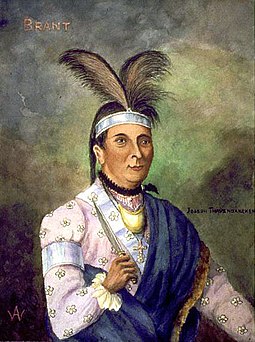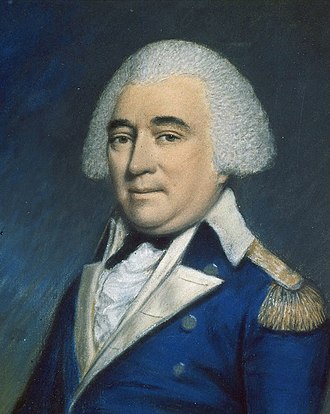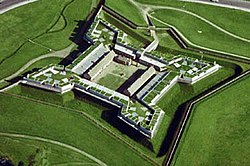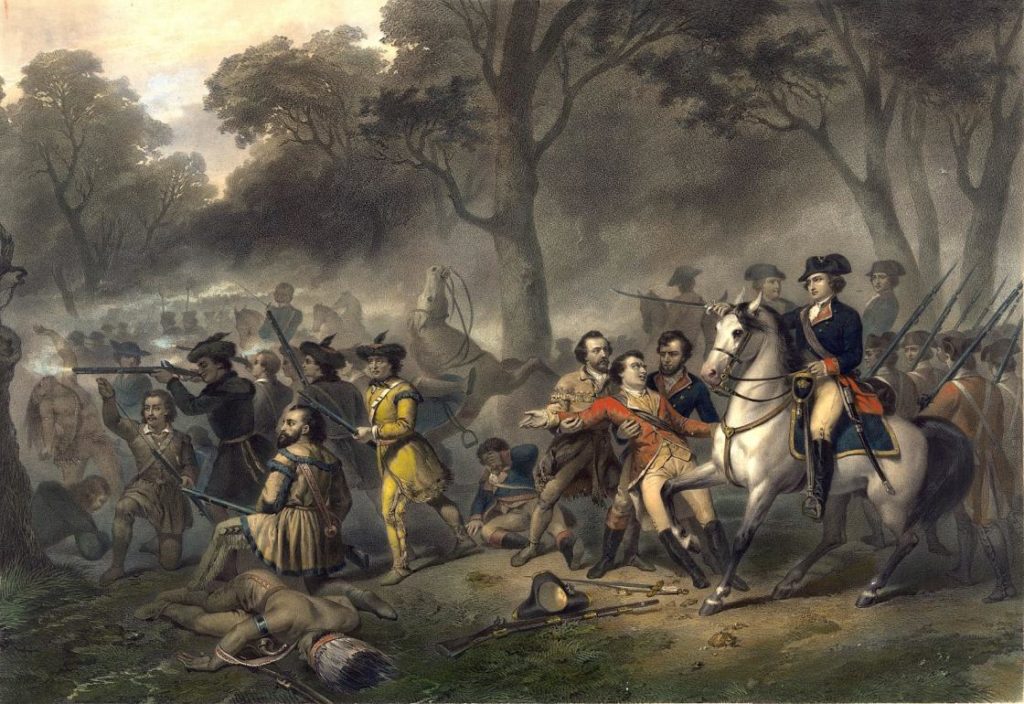Like smaller, weaker nations always and everywhere, the American Indians were blown in all directions by the hurricane of the American revolution. By 1778, only the Delaware and Oneida sided with the Americans. Across Iroquois country, Indian villages suffered attack by either the Americans or the British or Indians who sided with one or the other. The Indians near Fort Niagara were attacked so viciously that the very cold winter of 1779-80 left them close to starvation.
Ever the displomat, Guyasuta accompanied Cornplanter to the fort to plead with the British for help. It was their only hope. By this time, the Iroquois ability to hunt or wage war was so weak that they were reduced to begging.
Although offered only minimal help by his British allies, Guyasuta returned to the Ohio country in 1780 . He urged the Mingo people to remain loyal to the crown. Later in 1780, he led thirty Wyandot warriors in an attack on the Americans’ Fort McIntosh.
The Delaware and the Americans continued to attack Mingo villages. And Guyasuta became impatient with the British refusal to provide either protection or retribution. In the summer of 1782, he participated in a raid on the Patriot town of Hanna’s Town. The one-day fight destroyed thirty homes, dozens of acres of crops and 100 cattle. The town was never rebuilt. It was Guyasuta’s last battle.
In the 1782 Treaty of Paris that officially ended the war, the British signed over to the Americans all of their territory east of the Mississippi River. No one had consulted the Indians who lived there. They had no representative at the peace conference.
In 1784 and 1785, the Iroquois and the Mingo signed peace treaties with the United States, confirming the terms of the Treaty of Paris. But it was a mere formality. All was already lost. Once again, Guyasuta had backed the losing side.
The (Iroquois) Empire Strikes Back
The white men weren’t the only ones who broke treaty terms. Although the Indians had signed a peace treaty with the new United States, many young warriors refused to honor it. With the authority of the old Iroquois Confederacy weakened, bands of young warriors conducted freelance raids. Gradually, a new western confederacy of anti-treaty warriors emerged, supplied by British Canada. The frontier was still a dangerous place for isolated white settlers.
Against Guyasuta’s and Cornplanter’s objections, a former Mingo ally named Thayendanegea (also called Joseph Brant) assembled a force of 1500 warriors from the Wyandot, Shawnee, Delaware, Ottawa, Chippewa, Miami, Mingo, Creek and Cherokee tribes. Between 1786 and 1791, Thayendanegea’s army and their allies massacred 1500 settler families.
In 1791, President George Washington sent an army into the Ohio country led by Arthur St. Clair. But a near-bankrupt Congress could supply the army very poorly, and most of them were militia or 6-month draftees. Of the 2000 troops mustered, 600 deserted. The Miami general Little Turtle easily defeated St. Clair’s force.
Logstown: The Birthplace of the Professional United State Army
But Washington didn’t triumph in the Revolution by being a quitter. By the winter of 1792, Washington had selected General Anthony Wayne to lead the next attempt. Similar to Forbes in 1755, Wayne took a more methodical approach than his predecessor. From the 2500 soldiers remaining in the Continental Army and some new recruits from Pittsburgh, Wayne established the Legion of the United States.
He built a training camp at the abandoned site of Logstown (see this previous post), renaming it Legionville. Wayne spent the winter training and drilling his new army, which included Meriweather Lewis, William Clark and future president William Henry Harrison.
By this time, Guyasuta was about 70 years old. He had settled with two wives on a piece of fertile land along the Allegheny River near Pittsburgh.
Guyasuta visited the training camp twice. In his first visit during the winter, he asked for clothing and supplies. He also warned Wayne that the Western Confederacy was still on the warpath. His second visit took place in March of 1793. He pleaded with Wayne not to launch an attack on the Confederacy until all diplomacy was exhausted. But the Confederacy would settle for nothing less than a return to the 1768 treaty, which stipulated no white settlement west of the Ohio River. And the new United States would never agree to that.
Again like Forbes, Wayne built a string of forts between the fall of 1793 and the summer of 1794. Marching west, his Legion supplemented by 800 Kentucky militia, he burned every Indian village between present-day Fort Recovery Ohio and Defiance, Ohio, a distance of about 63 miles. The two towns still bear the names of the forts that Wayne built on their sites.
The Battle of Fallen Timbers
The Indians debated surrender, but decided to make one last stand. They chose a site near British Fort Miami, where they could still get supplies from the British and could retreat if needed. They thought this would be a good place to ambush Wayne’s army. On August 20, 1794, the forces of Little Turtle and Blue Jacket suffered defeat in the 80-minute Battle of Fallen Timbers. When they attempted to retreat to Fort Miami, they found it closed to them. Indian power in the Ohio country was finally completely beaten.
The peace treaty signed at Fort Greenville on August 3, 1795, ceded the Ohio river and most of the state of Ohio to the United States. In exchange, the Indians received a small annuity and a stipend of commodities.
Death of Guyasuta
Guyasuta had died just a few months earlier, in late 1794 or early 1795. He started his life in Logstown, a prosperous little town along the Ohio. And he ended it in another prosperous Ohio River town: the growing city of Pittsburgh. He had been a sachem, a warrior and a diplomat. In every war of his lifetime, he had the bad luck to choose the wrong side. His life as a representative of an empire in defeat tragically illustrates the fates of thousands of American Indians in the eighteenth and nineteenth centuries.
As a student in the Pittsburgh Public Schools in the 1960s and 1970s, I learned little about the fates of the original natives of our nation. They used to live here. Our white ancestors came and displaced them. Now they live on reservations in the west. The end. In this series about Guyasuta, I’ve tried to bring to life the people who were native to Western Pennsylvania before it was part of the United States. And I’ve tried to show parallels between them and other fallen nations. Nothing can ever do justice for the loss of their home. But they were the first Americans and it is right that we remember them.
If you are interested in learning more, I highly recommend Brady J. Crytzer’s book, listed in my Sources.
Sources:
Crytzer, Brady J. Guyasuta and the Fall of Indian America. Yardley, PA: Westholme Publishing, LCC, 2013.

